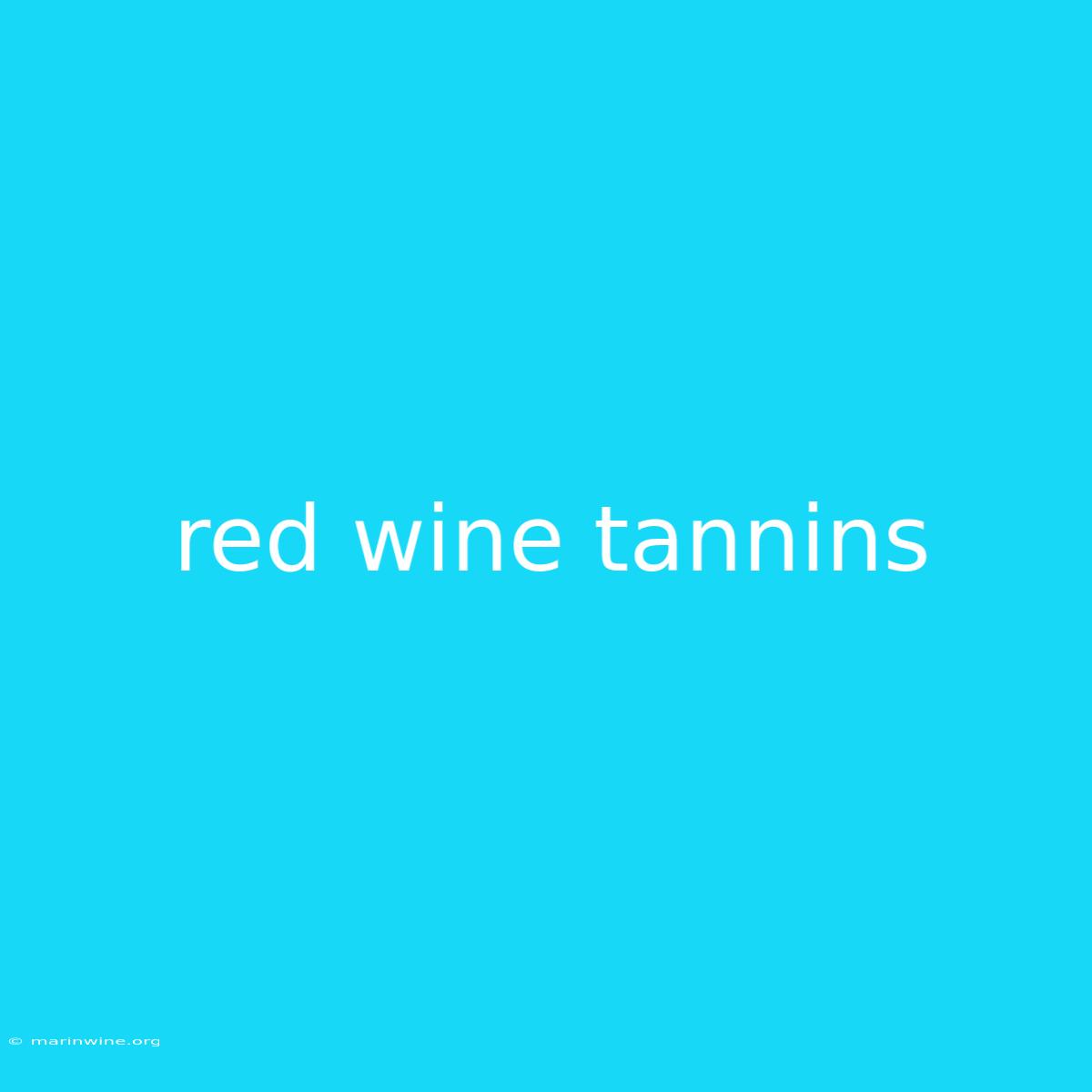Unlocking the Secrets of Red Wine Tannins: A Deeper Dive into This Complex Flavor
Have you ever wondered why some red wines taste bitter or astringent, while others have a smooth, velvety texture? The answer lies in the presence of tannins, powerful compounds that play a crucial role in the flavor and aging potential of red wine.
Why It Matters: Understanding tannins is essential for any wine enthusiast. It unlocks a deeper appreciation for the complexities of red wine, allowing you to make informed choices and identify the nuances of different varietals and vintages. This exploration delves into the world of tannins, explaining their origins, impact on flavor, and the factors influencing their levels in red wines.
Key Takeaways of Red Wine Tannins:
| Aspect | Description |
|---|---|
| Source | Derived from grape skins, seeds, and stems. |
| Flavor Profile | Contribute bitterness, astringency, and a drying sensation on the palate. |
| Impact on Wine | Affect structure, mouthfeel, aging potential, and overall complexity. |
| Factors Influencing Tannin Levels | Grape variety, winemaking techniques, climate, and soil. |
What are Red Wine Tannins?
Tannins are naturally occurring polyphenols found in various plants, including grapevines. They are responsible for the astringent, drying sensation you experience when drinking red wine. This sensation, often described as a "grip" on the palate, is a result of tannins' interaction with the proteins in your saliva.
Key Aspects of Red Wine Tannins:
-
Origins:
- Grape Skins: The primary source of tannins in red wine.
- Seeds: Contribute a more pronounced bitterness and astringency compared to skins.
- Stems: Contain tannins that can add a vegetal character if over-extracted.
-
Flavor Profile:
- Astringency: The primary characteristic of tannins, perceived as a drying sensation on the tongue and cheeks.
- Bitterness: A less intense flavor associated with tannins, sometimes perceived as a "rough" or "hard" taste.
- Structure: Tannins contribute to the "backbone" of the wine, providing a sense of weight and complexity.
-
Impact on Wine:
- Aging Potential: Tannins act as antioxidants, helping preserve the wine and allowing it to age gracefully, developing complexity over time.
- Mouthfeel: Tannins contribute to the overall texture and mouthfeel of the wine, from velvety smooth to robust and structured.
-
Factors Influencing Tannin Levels:
- Grape Variety: Different grape varieties have varying tannin levels. Cabernet Sauvignon, Syrah, and Merlot are known for their high tannin content.
- Winemaking Techniques: Maceration (soaking the skins in juice) and the length of fermentation affect tannin extraction.
- Climate: Warmer climates produce grapes with higher tannin levels.
- Soil: Soils rich in minerals can influence the concentration of tannins in grapes.
The Relationship Between Tannins and Wine Aging
Tannins play a crucial role in the aging process of red wine. As the wine matures, tannins soften and integrate with other components, leading to a smoother and more complex flavor profile.
Understanding the Evolution of Tannins:
- Young Wines: High tannins contribute to astringency and bitterness, potentially masking other flavors.
- Mature Wines: Tannins soften and integrate with other components, resulting in a smoother, more balanced wine.
- Over-Aged Wines: Tannins may become harsh and dominant, leading to an overly bitter or astringent taste.
Beyond the Flavor: The Health Benefits of Red Wine Tannins
While known for their impact on wine flavor, tannins offer potential health benefits too. They have been linked to improved cardiovascular health, antioxidant activity, and even anti-inflammatory properties.
Unveiling the Health Benefits of Tannins:
- Antioxidant Activity: Tannins protect against cell damage caused by free radicals.
- Cardiovascular Health: Studies suggest tannins may reduce cholesterol levels and improve blood circulation.
- Anti-Inflammatory Properties: Tannins may help reduce inflammation throughout the body.
FAQ about Red Wine Tannins
1. What are the best ways to enjoy a high-tannin wine?
- Decant: Allowing the wine to breathe in a decanter can help soften tannins.
- Pair with Food: Rich, fatty foods can help balance the astringency of tannins.
- Temperature: Serving the wine slightly cooler than room temperature can minimize the perception of tannins.
2. How can I tell if a wine is high or low in tannins?
* **Taste:** High tannins are often perceived as bitter or astringent, while low tannins are smoother and more delicate.
* **Color:** Deeply colored wines often have higher tannin levels.
* **Grape Variety:** Knowing the grape variety can provide clues about tannin levels.
3. Do tannins affect all wines in the same way?
- No, tannins vary in their intensity and characteristics depending on the grape variety, winemaking techniques, and aging process.
4. Can I taste tannins in other beverages?
* Yes, tannins are present in other beverages like tea, coffee, and even some fruit juices, contributing to astringency and bitterness.
5. Are tannins bad for my teeth?
* Tannins can stain teeth, but this is mainly a cosmetic issue.
6. How long does it take for tannins to soften in wine?
* It depends on the wine and its tannin structure. Some wines soften quickly, while others require years of aging.
Tips for Exploring Red Wine Tannins
- Start with Lighter Wines: Explore Pinot Noir, Beaujolais, or lighter-bodied red blends before moving to bolder wines.
- Experiment with Decanting: Notice the difference in texture and flavor before and after decanting a high-tannin wine.
- Pair with Food: Learn how different food pairings can complement and balance the tannins in red wines.
- Explore Different Regions: Discover the regional variations in tannin styles and levels.
Summary by Red Wine Tannins
Tannins are an essential component of red wine, influencing its flavor, structure, and aging potential. While often perceived as bitterness and astringency, tannins contribute to the overall complexity and enjoyment of red wine. Understanding their impact and exploring the nuances of tannins will deepen your appreciation for the diversity and beauty of red wine. Enjoy the journey of discovering the captivating world of red wine tannins!

